


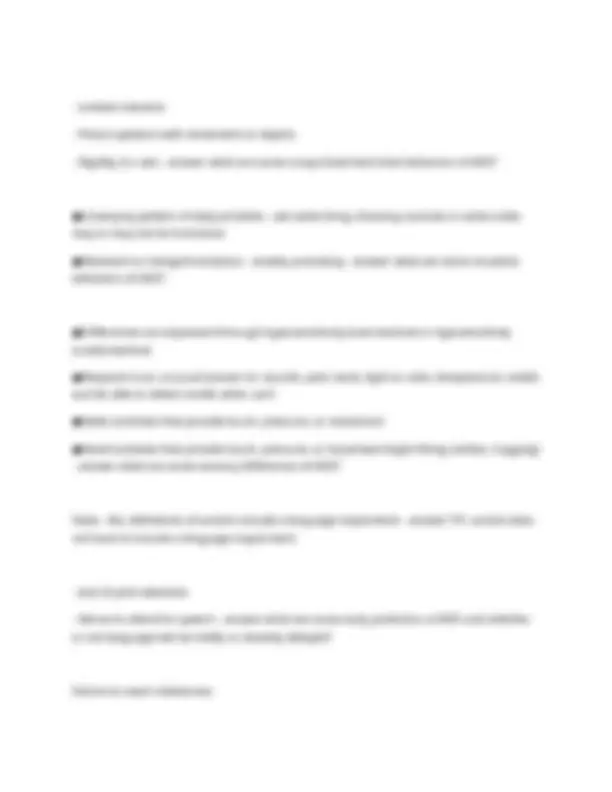
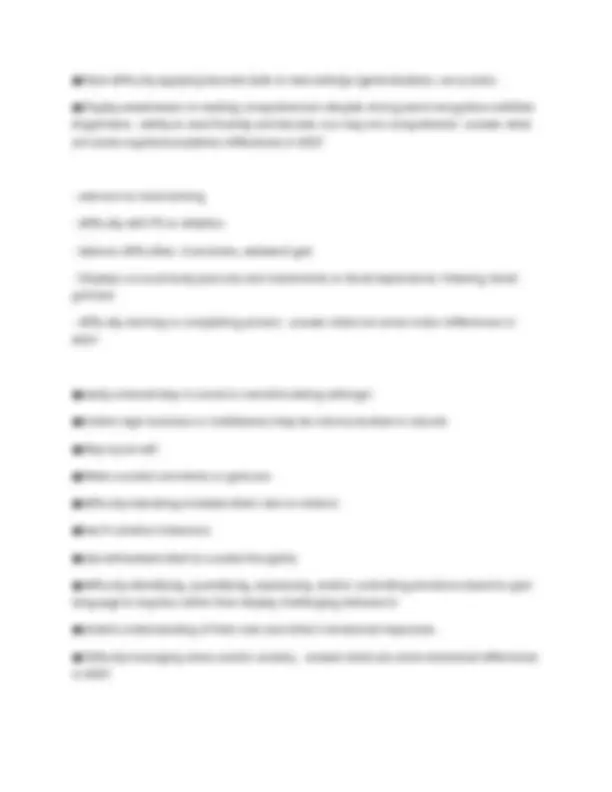
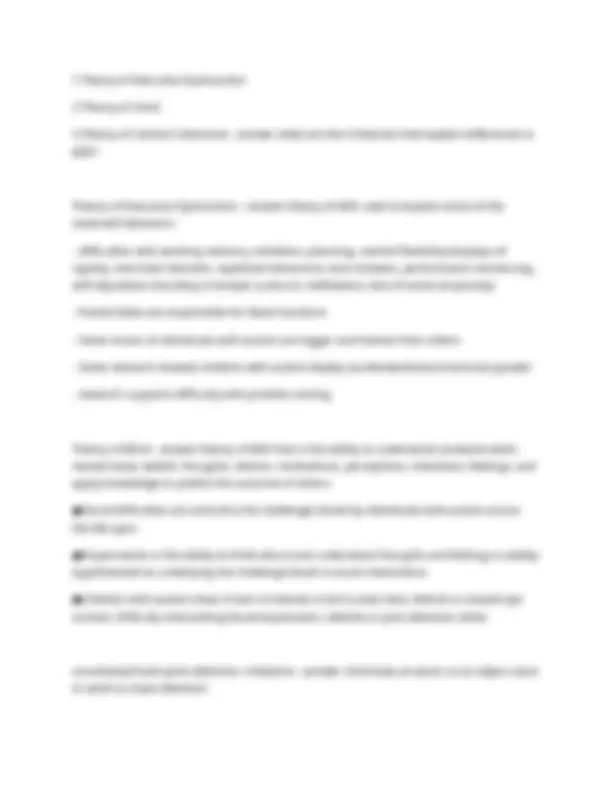

















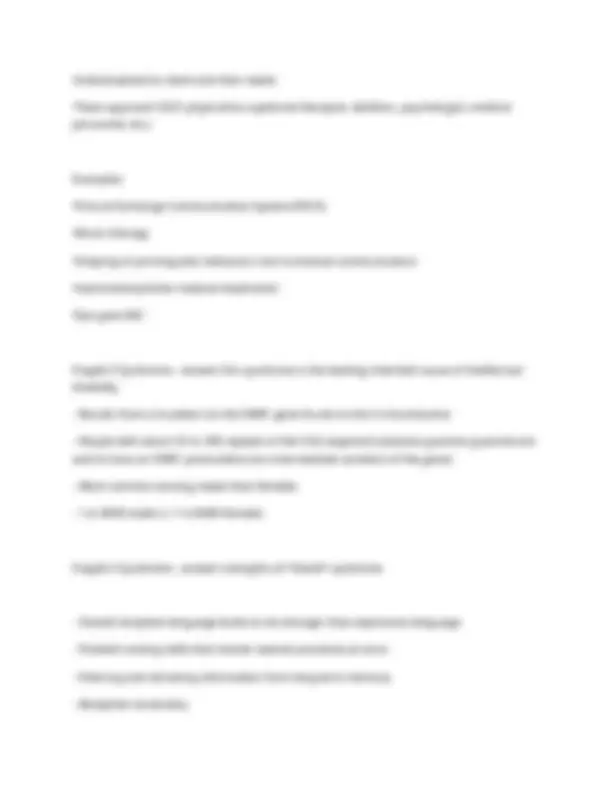
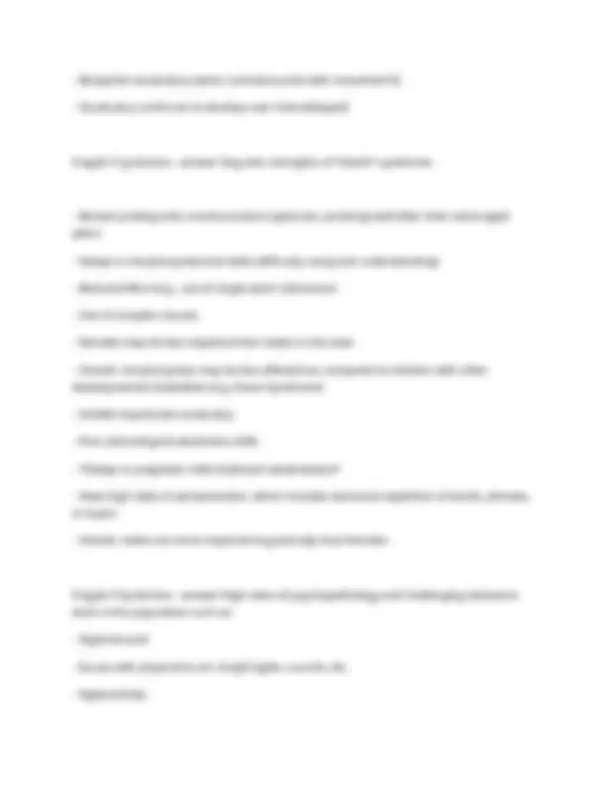
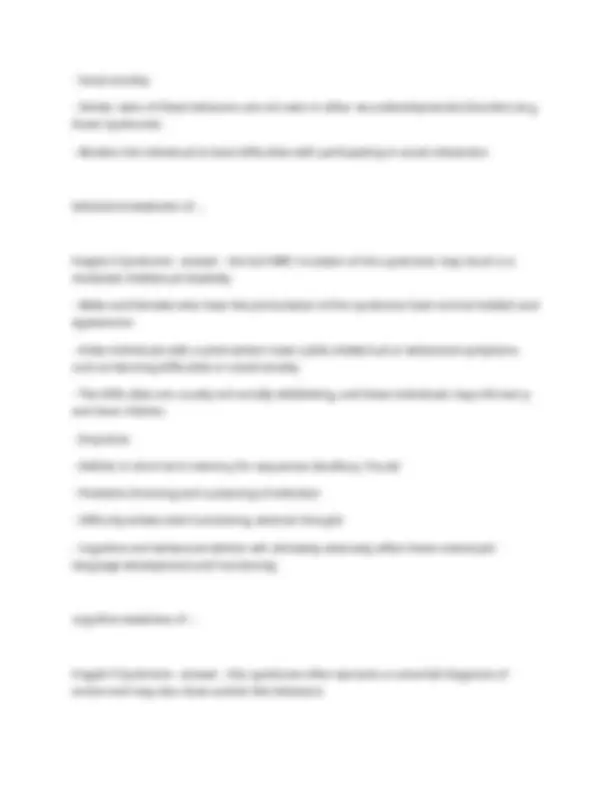




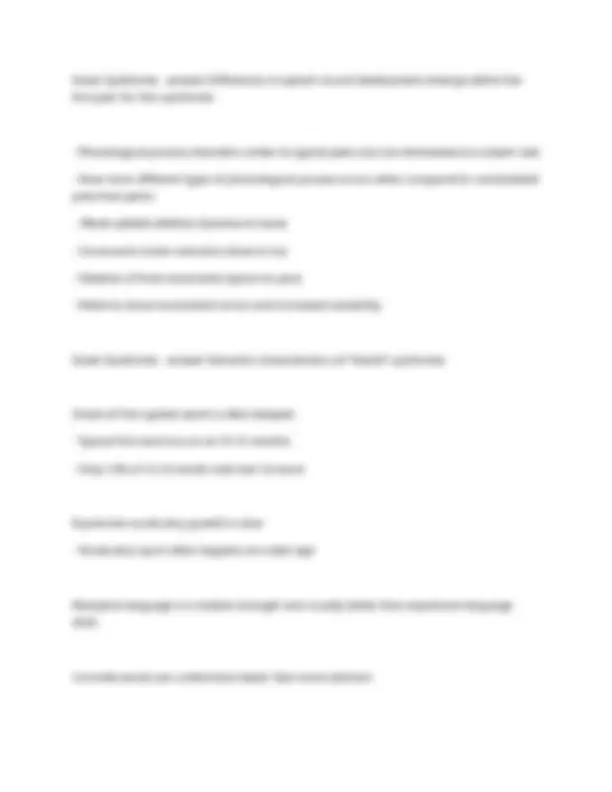




Study with the several resources on Docsity

Earn points by helping other students or get them with a premium plan


Prepare for your exams
Study with the several resources on Docsity

Earn points to download
Earn points by helping other students or get them with a premium plan
Community
Ask the community for help and clear up your study doubts
Discover the best universities in your country according to Docsity users
Free resources
Download our free guides on studying techniques, anxiety management strategies, and thesis advice from Docsity tutors
Developmental Disabilities Mod 1 Exam Questions And Complete Answers.
Typology: Exams
1 / 40

This page cannot be seen from the preview
Don't miss anything!

































DSM V - answer Diagnostic and Statistical Manual of Mental Disorders
autism - answer According to IDEA, blank is a separate category of disability that may require special education services autism - answer A developmental disability significantly affecting verbal and nonverbal communication, and social interaction, generally evident before 3, that adversely affect a child's communicative performance evident before 3 years old, stable diagnosis usually made before or around 2nd birthday - answer ASD age of onset Social Communication Disorder - answer an impairment of pragmatics and is diagnosed based on difficulty in the social uses of verbal and nonverbal communication in naturalistic contexts, which affects the development of social relationships and discourse comprehension and cannot be explained by low abilities in the domains of word structure and grammar or general cognitive ability social communication disorder is a diagnosis of disability in social communication without the presence of repetitive behavior, therefore excluding the person from ASD diagnosis - answer what differentiates social communication disorder from ASD? 1 in 44 American children - answer ASD prevalence 4 - answer ASD is blank times more common in boys than girls False - 4x more common in boys - answer T/F: ASD is more common in girls. 61-97% - answer what % of children w ASD receive SPED? True - answer T/F: Most of the developmental neurobiology of autism remains speculative and unconfirmed and there is no single cause.
ASD - answer There is a focus on pre- and post-natal environmental factors, especially: diet, drug exposure, environmental toxins environmental factors of... reasons for increased prevalence of ASD - answer ●Increased awareness by physicians and psychologists who make the diagnosis ●The broadening of the classification (DSM V diagnosis) ●Service availability
use and understanding ●Failure to develop peer relationships appropriate to his/her age ●Don't seek to share enjoyment ●Don't typically share interests ●Don't show, bring, or point out objects of interest ●Don't play social games ●Prefer to play alone ●May be oblivious to other children "tune out the world" ●May have no concept of other's needs ●May not notice when someone is distressed - answer what are some social and communicative differences in ASD? ●Are concrete thinkers: literal in understanding of certain concepts ●Display poor problem-solving skills: look at details and not at bigger picture ●Demonstrate poor organizational skills. ●Have attention problems. ●Have strong impulses. ●Easily distracted by unrelated details: has difficulty knowing what is relevant or makes off-topic comments ●Has difficulty understanding the connection between behavior and resulting consequences (cause and effect): often will require direct instruction in this skill ●Recalls information inconsistently: what they know one day, they may not know the next day ●May display extensive knowledge in narrow areas of interest. - answer what are some cognitive differences in ASD?
●Have difficulty applying learned skills in new settings (generalization, carry-over). ●Display weaknesses in reading comprehension despite strong word recognition abilities (Hyperlexia - ability to read fluently and decode, but may not comprehend) - answer what are some cognitive-academic differences in ASD?
showing (joint attention: initiation) - answer child holds toy out to adult to share attention give to share (joint attention: initiation) - answer clear attempt to give an adult a toy for the sole purpose of sharing point (joint attention: initiation) - answer points to an object to direct attention to thing of interest following point (joint attention: responses) - answer skill after an adult points to an object, where child responds by following adult's point and looks at item/action following gaze (joint attention: responses) - answer child follows adults gaze to look at something Theory of Central Coherence - answer theory of ASD describing an individual's inability to interpret context/integrate information into a meaningful whole.
40% - answer Approximately blank % of individuals with ASD do not develop functional speech and fall into the category of non-verbal. 25-30% - answer blank % of individuals with ASD will demonstrate language skills and then regress as they grow older. This will occur about 1-2 years of age. 90% - answer blank % of individuals with ASD have sensory abnormalities, such as over or under arousal or sensitivity 41% - answer blank % of individuals with ASD have intellectual disabilities 61-97% - answer blank % of individuals with ASD will require special education services echolalia - answer The socially awkward or inappropriate verbatim repetition of part or all of a previously spoken utterance palilalia - answer usually considered a disorder of speech and not of language. It manifests as a delayed repetition of words or phrases that are just uttered by the client delayed echolalia - answer repetition of an utterance more than 2 conversational turns after initial utterance immediate echolalia - answer immediate repetition of an utterance immediate interactive echolalia - answer type of echolalia produced for a communicative
•Excessive chewing/mouthing behaviors •Strabismus receptive language characteristics of Angelman syndrome - answer •Receptive skills are more developed than expressive language skills. •Vocabulary skills are significantly reduced. •Sentence comprehension is limited. expressive language characteristics of Angelman syndrome - answer •Lack of cooing or babbling •Lack of vocalizations •Limited use of nonspeech communication •Little or no functional speech: rely on nonverbal communication •repertoire: vowels and easy consonants (inconsistent) •good candidates for AAC cognition characteristics of Angelman syndrome - answer •Severe to profound deficits •Difficulties with learning, attention, and memory •Problems understanding the purpose of objects •Problems with abstract thinking •Problems imitating swallowing characteristics of Angelman syndrome - answer •Infants: poor suckling and sucking capabilities •Children: different problems with Rumination
oPica oExcessively putting their hands in their mouths •May have gastroesophageal reflux disorder behavior characteristics of Angelman syndrome - answer •Unusually happy •Characteristics include:
•Micrognathia are facial features of... Prader-Willi Syndrome - answer - Hypotonia
Prader-Willi Syndrome - answer •Poor receptive and expressive language skills •Pragmatic language weaknesses •Intellectual disabilities •short-term memory deficits •poor narrative retell and sequencing •shorter MLU •strengths in long-term memory and wide range of expressive language language and cognitive characteristics of ... Prader-Willi Syndrome - answer •Irritability (esp during transitions) •Anger •Temper tantrums •Stubbornness •Low frustration tolerance •Anxiety •Compulsive eating (hyperphagia) •Self-injurious behaviors like skin picking behavioral characteristics of ... Prader-Willi Syndrome - answer co-morbidities of blank : •Obesity